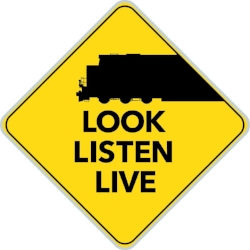An Interview with Operation Lifesaver
This page was last reviewed on August 16, 2017

Tell our network, what is Operation Lifesaver?
Operation Lifesaver (OL) is a not-for-profit that works to educate Canadians about rail safety. We’re funded by Transport Canada and the Railway Association of Canada, and we partner with railways, governments, safety councils, police, labour and community groups, and other safety-focused organizations like Parachute to raise awareness about the hazards of rail crossings and trespassing on railway property.
Each year, our partners and volunteers make more than 500 presentations in schools and at community events, put on mock collisions to show people the impact of rail incidents, and conduct enforcement activities like trespassing and crossing ticketing blitzes. But more and more we’re using social media and innovative technologies to get our rail-safety message across.
During Rail Safety Week at the end of April, we launched our new Look. Listen. Live. campaign, featuring two virtual-reality videos that immerse viewers in a 3D environment and allow them experience the actual dangers of trespassing on rail property or driving their cars around lowered crossing gates.

What is the burden of injury for railways?
More than 100 Canadians are seriously injured or killed each year when they put themselves in unsafe situations around railway tracks and trains. A train hits a vehicle or a person almost every day in Canada, and most of the victims are young people aged 18 to 25. Virtually all of these incidents could be avoided.
Those who are lucky enough to survive an incident with a train are often left with very serious injuries — they lose limbs, suffer severe burns or are paralyzed. And those are just the physical injuries.
And it’s not just the immediate victims of these incidents who are impacted – rail-related incidents affect their families and friends, railway employees, emergency responders and entire communities. This is something that Scott Sackaney – a young man who was hit by a train in 2012 and who we profiled as part of our Look. Listen. Live. campaign – articulated really well. I’d highly recommend watching his story on LookListenLive.ca.
What are some emerging trends when it comes to railway safety?
Last year, the number of trespassing incidents and deaths in Canada rose above the five-year average; there were a total of 69 incidents and 46 deaths related to trespassing (up from 50 and 30, respectively, the year before). And that trend appears to be repeating itself again this year, which is very concerning to OL.
Earlier this year, we launched a series of anti-trespassing PSAs to highlight why people shouldn’t trespass on railway property, and we’re hoping that our new virtual-reality video about trespassing will deter people as well.
How is this still an issue?!
People have a lot of misconceptions about trains, and I think that’s part of why we still see a significant number of railway crossing and trespassing incidents. OL focuses on challenging common myths on social media and when we do face-to-face outreach in communities. We remind people that:
Trains don’t have steering wheels. They can’t swerve or stop on a dime. It can take the length of 18 football fields — 2 kilometres — for a train to stop.
Today’s trains are remarkably quiet. In fact, they can be silent killers — you won’t necessarily hear one until it’s too late.
Because of their large size, trains often appear to be farther away and moving more slowly than they actually are.
You definitely don’t want to have a run-in with a train — the average train is 4,000 times heavier than the average vehicle. A train hitting a car is like a car hitting a pop can.
What lessons have you learned in terms of the public policy process and implementing change? How does that relate to the implementation of Vision Zero in Canada?
We’re very fortunate that the federal government has recognized the need for rail safety education and awareness in Canada, and increased Operation Lifesaver’s funding for the next three years. That being said, safety is a shared responsibility, and we need active partners at all levels of government and beyond if we’re going to reach our goal of zero rail-related incidents in Canada.
OL is hoping to influence public policy around rail safety by making a submission as part of the federal Railway Safety Act Review. We’ll be focusing on the need for greater engagement on rail safety at the provincial level, for better data on crossing and trespassing incidents, and for increased funding and a holistic strategy for preventing rail-related suicides.
Anything else you would wish the network would know? What’s next for Operation Lifesaver?
We would encourage Parachute’s network to visit LookListenLive.ca and to experience our campaign videos for themselves. Don’t worry if you don’t have a virtual reality headset — there are 2D versions of the videos on the site that you can experience. We’d also encourage people to share the videos on social media using the hashtags #SHARETHESCARE and #LookListenLive, to help OL to spread its rail safety message.
In terms of what’s next, we’re planning to produce some additional virtual-reality videos aimed at different target audiences – winter sports enthusiasts, professional drivers, etc. We’re also in the process of redesigning our main website, refreshing all of our communications tools and working with organizations like Parachute to disseminate our campaign materials. Next year we’ll be developing new driver training modules as well. The best way to keep up-to-date with all of this is to follow us on social media (Twitter/Instagram: @OpLifesaver; Facebook: @OperationLifesaver) and to sign up for our newsletter at operationlifesaver.ca.
